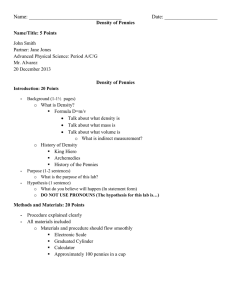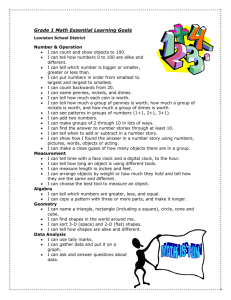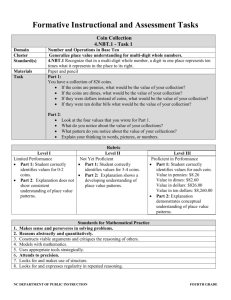Begin Math Facts Quizzes –Addition Unit 5 Pre-Assessment 5
advertisement
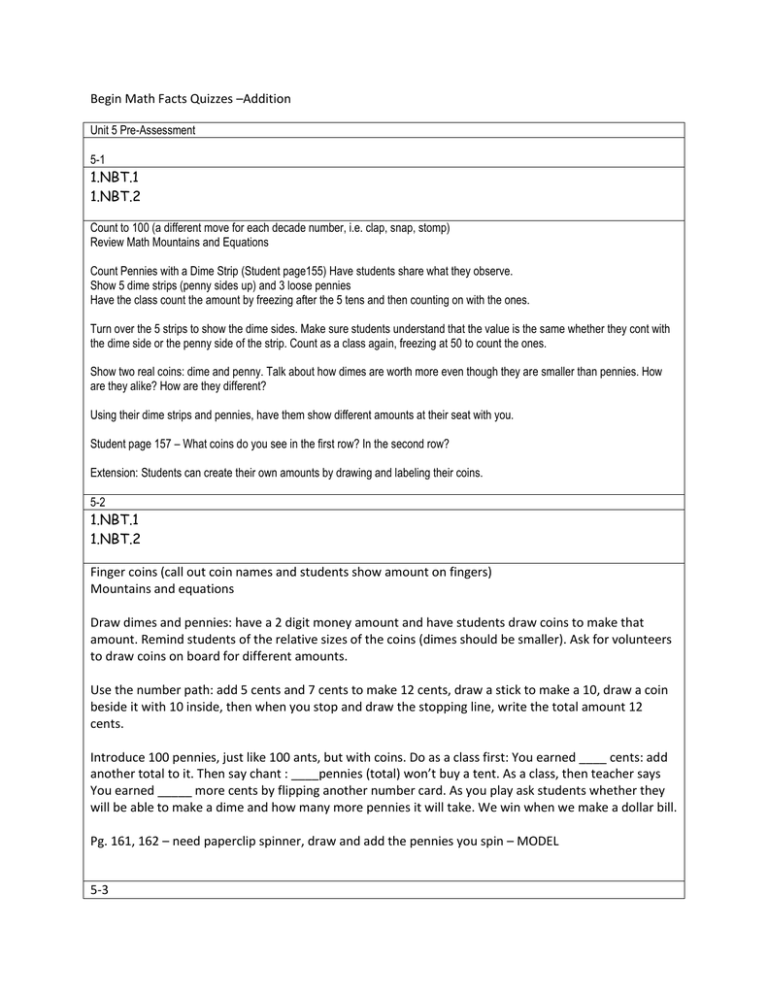
Begin Math Facts Quizzes –Addition Unit 5 Pre-Assessment 5-1 1.NBT.1 1.NBT.2 Count to 100 (a different move for each decade number, i.e. clap, snap, stomp) Review Math Mountains and Equations Count Pennies with a Dime Strip (Student page155) Have students share what they observe. Show 5 dime strips (penny sides up) and 3 loose pennies Have the class count the amount by freezing after the 5 tens and then counting on with the ones. Turn over the 5 strips to show the dime sides. Make sure students understand that the value is the same whether they cont with the dime side or the penny side of the strip. Count as a class again, freezing at 50 to count the ones. Show two real coins: dime and penny. Talk about how dimes are worth more even though they are smaller than pennies. How are they alike? How are they different? Using their dime strips and pennies, have them show different amounts at their seat with you. Student page 157 – What coins do you see in the first row? In the second row? Extension: Students can create their own amounts by drawing and labeling their coins. 5-2 1.NBT.1 1.NBT.2 Finger coins (call out coin names and students show amount on fingers) Mountains and equations Draw dimes and pennies: have a 2 digit money amount and have students draw coins to make that amount. Remind students of the relative sizes of the coins (dimes should be smaller). Ask for volunteers to draw coins on board for different amounts. Use the number path: add 5 cents and 7 cents to make 12 cents, draw a stick to make a 10, draw a coin beside it with 10 inside, then when you stop and draw the stopping line, write the total amount 12 cents. Introduce 100 pennies, just like 100 ants, but with coins. Do as a class first: You earned ____ cents: add another total to it. Then say chant : ____pennies (total) won’t buy a tent. As a class, then teacher says You earned _____ more cents by flipping another number card. As you play ask students whether they will be able to make a dime and how many more pennies it will take. We win when we make a dollar bill. Pg. 161, 162 – need paperclip spinner, draw and add the pennies you spin – MODEL 5-3 1.NBT.1 1.NBT.2 Jenny’s Pennies: How many cents can I give to Jenny? I have 6 bright dimes and 7 bright pennies. (67 cents) Finger coins Mountains and Equations Suggest problem solving Strategies: Set up stations with countable objects. Tell children they need to count all of the objects. Ask if they can think of a way to share this task? Discuss their suggestions. It would take a long time for just one of you to count all of these things. Is there a way for everyone in the group to share the work so that it will go faster? Now have students put items into groups of tens. Then show the number with the blue secret code cards. Ungroup objects and switch stations. Student Page 163: Count and color 10-groups “Who can explain how they found the answer?” Discuss strategies. 5-4 1.NBT.1 1.NBT.2 1.NBT.3 Jenny’s Pennies: Convert dimes and pennies to cents. How many cents can I give jenny? I have 9 bright dimes and 3 bright pennies. Finger coins. Math mountains. Fact Family House Add and convert coin amounts. Use pennies to show 8 + 5, draw a stop line under the eighth penny. Write the equation to match. Discuss showing the same total with dimes and pennies. Write new equation to match. Practice with a story problem: Megan bought a pencil for 7 cents and an eraser for 5 cents. Show the total as a dime and pennies on your grid. Introduce a teen coin problem: 7 cents + 6 cents. Use back of board to solve. Discuss ways to solve if you didn’t have coins or a board. Make a ten strategy. Write 7 and draw 6 dots, makes 13 cents. Then draw coins with a dime and 3 pennies. Ringing the 10 in the first drawing. Practice make a ten strategy. Solve coin story problems: Joel spent 6 cents on a balloon and 8 cents on a birthday card. What is the total in dimes and pennies. Sara earned 7 cents mowing the lawn and 9 cents pulling weeds. Give the total in dimes and pennies. 5-5 1.NBT.1 1.NBT.2 1.NBT.3 Jenny’s Pennies Finger Coins Mountains and equations Have items pre-priced for students to buy. At least 4 cents and no more than 9 cents. Make a pricelist for students to view. Have the class select two items to buy that will have a total greater than 10. Which two things do you want to buy first? Write an equation on the board to show the two items. Have students lay out the coins at their desk to buy the items. How can we pay for these items with a dime and some pennies? Buying with dimes, nickels, and pennies: Substitute a nickel. Adjust the price list so that there are more totals of 15, 16, 17, and 18. What is the total? (17 cents) All of you have a dime and 7 pennies on your desks. Is there a way to pay for these things without counting out so many coins? Could you change some or all of the pennies for another dime? Could you change some or all of the pennies for a nickel? Extension: Read aloud “My Rows and Piles of Coins” 5-6 1.NBT.1 1.NBT.2 1.NBT.3 Finger Coins Jenny’s Pennies Math mountains and equations Using mathboards, have students create a 100-grid. A hundred grid shows all the numbers from 1 through 100 in groups of 10. Where do you see groups of ten? (ten numbers down and ten across) Look at each vertical column. Tell me about the tens and ones. You can see how the ten stays the same while the ones go from 1 to 9. Then the ten gets 1 greater. Look at the horizontal rows. Tell me about the tens and ones. Draw 10 sticks and circles for each number. Look at the third row. How many ones are there in each number? How many tens? Let’s make this pattern with sticks and circles. Discuss the pattern and why it happens. Make a rectangle around the seven squares below 3 and the three squares 11, 12, and 13. Add ten using the hundred grid: Find 47 on the grid and now add ten. “56 beetles on the floor. Add ten more” Student page 165. Filling in a number board with tens and ones. 5-7 1.NBT.1 1.NBT.2 1.NBT.3 Beetle Rhyme: ___ beetles on the floor, add ten more. Mountains and equations Introduce 10 based number sequences: Student Page 167. Practice counting the patterns (1’s, 2’s – 2, 12, 22, 32, 42) Then have students make up their own pattern sequences. The leader gives the first 3 numbers, and the other children join in and continue the number sequence. Identify numbers by tens and ones. Ring every number with 5 ones in red. Ring every number with 7 tens in blue. Ring every number with 2 ones in green. Ring every number with 3 tens in orange. Discuss why some numbers have more than one ring around them. Adding multiple tens: Use the hundred grid to add tens. 79 + 20. Where do you start to count? Which way will you go and why? How many spaces do you move to add 20? Practice adding tens without the grid by drawing sticks/circles and counting up. Student page 168 – putting decade numbers in order from least to greatest. 5-8 1.NBT.1 1.NBT.2 1.NBT.3 Count backward 3 numbers – 120 poster and pointer 5:4,3,2, 70: 69, 68, 67. 61: 60, 59, 58 Money Routine Math Mountains – led by student leaders 10 partners on the dime strip Page 169 – how many pennies on the dime strip? 10 pennies What are some of the partners of 10? Focus on 6 and 4. how many pennies are left? A dollar bill and its worth. A dollar bill, 100 cents, 100 pennies. 100 partners on the penny array: just as there are partners of 10, there are partners of 100. pennies are in columns of 10 pennies each, and 10 columns in all. Demonstrate how to use the break-apart stick. 6 and 4, 60 and 40, 6 tens and 4 tens = 10 tens = 100. Discover the partners of ten and 100 at bottom of page 169. Solve story problems and explain solutions: On back of page 169, have students show work and solve this problem: Jamal has 70 cents. He needs a dollar to buy a bag of peanuts. How many more cents does Jamal need? 30 cents. Have students share their own story problem that is similar and share their strategy for solving. Intervention: fold paper in half. Write number on top from 1 to 9. Draw blue circles to show the number. Draw that many 10 sticks on the bottom. Partner 2, draw red circles to make a ten and draw red sticks to make 100. On level: mix card 10- 90 and place face down in rows. Turn over 2 cards, If the numbers are 100 partners, keep them, if not, turn back over. Challenge: mix cards 10-90 and place face down in a pile. Take a card, how many more tens are there to 100? 30 = 70 more tens to 100. keep the card if you are right, put back under the bottom if you are wrong. 5-9 1.NBT.1 1.NBT.2 1.NBT.3 The beetle rhyme: add 1 or 10 to 2 digit numbers. 45 beetles on the floor, add 1 more, or add 10 more. Count backwards 3 numbers. Mountains and equations. Solve equations with unknown 100 partners. Write on the board the equations and have students share their strategies. 70 + __ = 100, 40 + ____, 50 + _____, 80 + ____ Solve story problems with unknown 100 partners. Nadia needs a dollar. She has 70 cents. How much more money does she need? If students are unsure, have them draw 10 sticks, ring the known partner, and count the unknown. Dim detective: one player, the detective, closes his or her eyes, while the other player covers some of the dimes with a sheet of paper. The detective tries to discover how much money is hidden. Then switch roles. Intervention: put all dimes in envelope (10). Take some dimes, count them and say the value. Partner 2, writes a matching 100partner equation. 40 + ____ = 100. Partner 1, count on by tens or draw 10 sticks to solve. On level: make a price list for 6 kinds of fruit. Draw the fruit on the cards. Mix the cards and place them face down. Partner takes a card. Buy the fruit using one dollar. Tell how much money is left. Take turns. Challenge: put the 10 dimes in the envelope. Secretly take out some dimes. Partner 2 looks in envelope. Writes a matching 100partner equation. Solve. Partner 1 shows their dimes to check the answer. 5-10 1.NBT.1 1.NBT.2 1.NBT.3 The beetle rhyme Count backwards 3 numbers Math mountains Page 173 – different ways, same amount Circle correct number of pennies, by counting by 10s and 1s Share with class different coins to use to make that amount (show on board with magnet coins). Explain that it is easiest to pay for something using the fewest coins possible. Students draw the fewest coins possible under the fruit. Direct students that starting with the largest coin amount first is easiest, dimes, nickels, then pennies. Coin story problems: Draw coins using fewest coin amounts. Solve 2 digit coin stories: Omar wants to buy a card for 68 cents. Show him how he can pay with the fewest coins. 6 dimes, 1 nickel, 3 pennies Tessa is buying a stamp for 34 cents. How can she pay with the fewest coins? 3 dimes, 4 pennies Mike is buying a pencil for 75 cents. He paid with 7 dimes and 5 pennies. Did he pay with the fewest coins? No there would be fewer coins if he paid one nickel for 5 pennies. Intervention: each partner fold a paper in 4 parts. Write an amount between 20 and 90 cents in each part. Draw coins for the first amount, start with dimes, count by tens. Then draw pennies. Count by ones. Use the penny array to help you. Repeat for the other amounts. Onlevel – Work together. Make a flyer for 5 bake sale items. Make all the prices less than $1. Trade flyers. Draw the fewest coins needed to buy each item. Use only pennies, nickels, and dimes. Challenge: Name an amount between 30-40 cents. Make a list of all the ways you can show the amount. Use pennies, nickels, and dimes. Repeat with other amounts. Compare methods. 5-11 1.NBT.1 1.NBT.2 1.NBT.3 Unknown addends with teen totals: Partner pairs: first leader has 1 digit cards, other has 2 digit cards. Take turns asking class for the 10 partner and the 100 partner. Math mountains and equations Solve a story problem and share methods of reaching solution. Change the form of the problem. Total vs. partner given first. Invent teen total story problems: give equation, let students make story problem. Introduce make a ten strategy: counting on with dots, fingers OR make a ten, with dots and ring a ten, or 8 + 2 dots + 4 dots = 8 + 6, ring the dots to find missing partner. Introduce purple make-a-ten cards. Practice finding unknown addends. Page 179 solve and match 5-12 1.NBT.1 1.NBT.2 1.NBT.3 Partner pairs – Students hold up a ones secret code card and another student holds a decade number card. The class guesses the 10-partner (3 + 7) or the 100-partner (60 + 40). Mountains and equations Solve a story problem with a Teen Total: 13 giraffes marched in a parade. It started to rain, and 7 of them went home. How many are left? Have several students solve the problem on the board in different ways. Share strategies and ask, did they all get the same answer? *Show 7 + __ = 13. Connect this to a subtraction equation. Use groups of 5 in your circle drawing. Then check your subtraction work by using addition and the make a ten strategy. (7 + 3 + 3 = 13) Invent Teen subtraction problems: 17-8 = ___ Introduce the make a ten strategy: 14-8 = ____ Show the counting all (drawing 14 circles and taking away 8), and counting on (start at 8 and count up to 14) How many more do I need to make a ten from 8? How many more do I need from 10 to make 14? How can I use these numbers to find the answer to 14-8? Introduce the blue make a ten cards: Look through your cards, how do they show how to find the answer? What do you think the dots show on the cards? Why do you think there are numbers below the dots? Why do you think the cards are called make a ten cards? Practice Teen Subtracting: Sort cards into piles based on the known partners (all -9, -8, -7 together). Convert coins before solving: I had 15 cents. I spent 1 nickel and 3 pennies. How many cents do I have left? Kelly had 14 cents. She paid 1 nickel for a new sticker. How many cents does Kelly have now? Student page 185 (Match an equation with the matching make a ten picture) 5-13 1.NBT.1 1.NBT.2 1.NBT.3 Partner Pairs Mountains and Equations Explain to the class that the story problems today will all be mixed together. There will be some with unknown totals and some with unknown partners. Solve with math mountains: There are 16 flowers in the vase. 7 are white and the rest are red. How many are red? There are 7 white flowers and 9 red flowers in the vase. How many flowers are there in all? Hannah had 11 cents. She spent a nickel. How many cents does she have now? There are 6 turtles in the river. There are 8 turtles on the shore. How many turtles are there in all? Scott has 17 baseball caps. 8 of them are blue. The others are red. How many caps are red? Number grabber: using math mountains. Students may erase a number in any positions. Now try to play with equations. Have students write story problems (3 teen number problems) with unknown total, unknown addend, and subtraction. Student page 187 –creating different equations from math mountains. 5-14 1.MD.4 1.G.1 1.G.2 Partner Pairs: Mountains and equations Hand out story problems from yesterdays lesson. The reader for each group reads the first problem aloud. Each child solves the problem independently. Listen carefully while the reader reads the story problem. Read it again together with everyone pointing to each word. Then everyone can work on it alone. When they are finished, have them compare their strategies. If they got different answers, they should discuss the matter and offer to help each other. This should be a cooperative effort. When most of you have solved the problem, discuss it together. There may be different ways to do it. Check to see if you all got the same answer. If someone can’t find the answer, help that person. Do all of you have to solve these problems the same way? Should everybody get the same answer to the same problem? What should you do if the children in your group get different answers? Practice make a ten strategy with both blue and purple cards. Student page 189 – Matching make a ten pictures to equations Unit 5 Assessment 1.MD.4 1.G.1 1.G.2

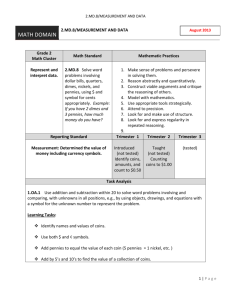

![Unit 1 Math Study Guide [9/25/2013]](http://s3.studylib.net/store/data/007176565_1-e73b60b55200467df1b962c5217f1e9a-300x300.png)
